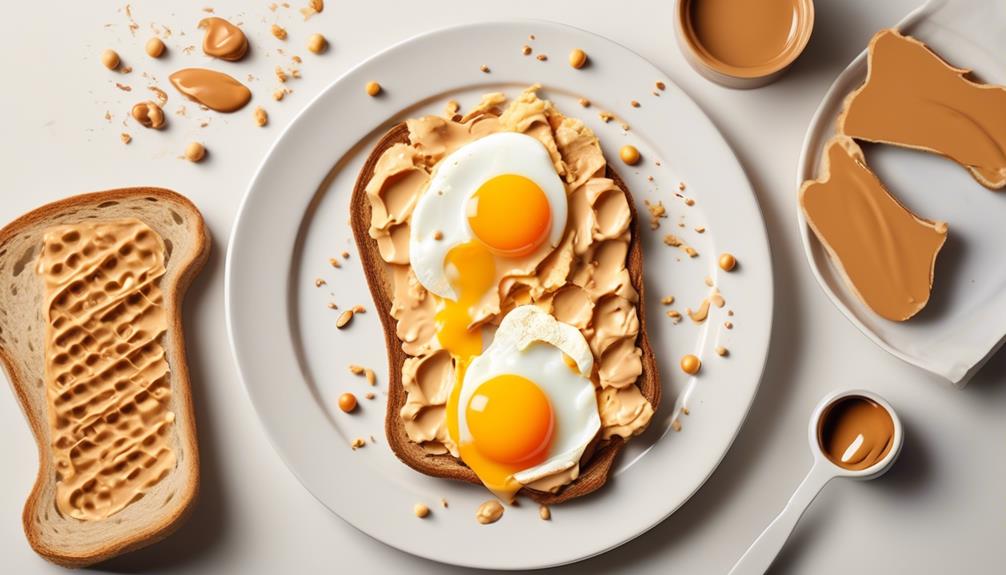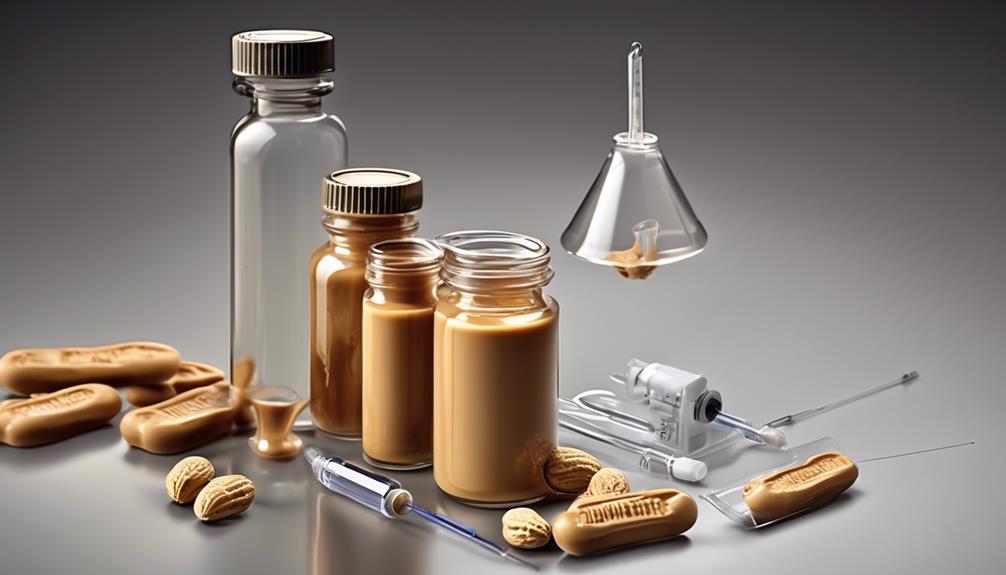When it comes to preparing a peanut butter sandwich, we see it as a basic yet fulfilling culinary routine. The rhythmic spreading of creamy peanut butter, the smooth swirl of jelly, and the gentle joining of two slices of bread.
But beyond this poetic imagery, there are key steps and thoughtful considerations that elevate the humble peanut butter sandwich to a delightful experience.
So, if you're craving a timeless classic that holds endless potential for personalization, stick around as we uncover the art of crafting the perfect peanut butter sandwich.
Key Takeaways
- Choose the type of peanut butter and bread that suits your preferences.
- Handle the ingredients with care to maintain the integrity of the sandwich.
- Spread the peanut butter and jelly evenly on the bread slices.
- Consider personal taste when deciding whether to remove the crusts and how thick to spread the fillings.
Gather Your Ingredients
Let's gather our ingredients for making a delicious peanut butter sandwich. First, we need to grab the peanut butter and bread. Make sure to choose a smooth or crunchy peanut butter, depending on your preference. As for the bread, opt for a fresh and soft loaf, whether it's whole wheat, white, or a specialty bread like sourdough or multigrain.
After ensuring we have the necessary ingredients, it's essential to lay them out for easy access. Place the jar of peanut butter and the loaf of bread on the countertop, making sure they're within reach. This preparation will streamline the sandwich-making process, allowing for a seamless assembly.
When handling the bread, be gentle to avoid squishing or tearing it. If the bread is stored in the refrigerator, consider letting it come to room temperature to enhance its texture and flavor. Additionally, if you prefer warm peanut butter, you can lightly toast the bread before spreading the peanut butter on it.
Put Gloves on (optional)

Consider wearing gloves to avoid getting peanut butter and jelly on your hands, ensuring a cleaner and more convenient sandwich-making experience. Wearing gloves can help keep your hands clean while spreading the peanut butter and jelly on the bread.
It's a personal choice, so if you prefer not to wear gloves, just be sure to wash your hands thoroughly after making the sandwich. Some people find that using gloves makes for easier cleanup, as you can simply remove them and dispose of any mess.
However, if gloves feel cumbersome or unnecessary to you, feel free to skip this step. It's all about what makes you feel comfortable and efficient in the kitchen. Whether you choose to wear gloves or not, the most important thing is that you enjoy making and eating your peanut butter sandwich.
Pull Out Two Slices of Bread

If you have opted to wear gloves, carefully pull out two slices of bread from the loaf, ensuring they remain intact to avoid any tearing or crumbling. Gently separate the slices, making sure they are not stuck together. Placing them on a clean surface will prepare us for the next step, which is spreading the peanut butter. Using fresh bread slices will ensure the best taste and texture for your peanut butter sandwich.
| Step | Description |
|---|---|
| Step 1 | Pull out two slices of bread from the loaf carefully to avoid tearing. |
| Step 2 | Ensure the slices remain intact and not stuck together. |
| Step 3 | Place the slices on a clean surface to prepare for spreading the peanut butter and jelly. |
Pulling out the bread slices without tearing them is crucial to maintaining the integrity of your sandwich. By being gentle and deliberate, we ensure that each slice is perfectly ready for the next step. This attention to detail sets the stage for a delicious peanut butter sandwich, and we are on our way to creating a delightful snack.
Open Peanut Butter and Jelly

After gathering the peanut butter, jelly, and bread, we open the jars and remove the seals before stirring the contents if necessary.
- Open the Jars:
- Carefully unscrew the lids of the peanut butter and jelly jars to avoid spilling.
- Gently lift off the seals to ensure no bits of paper fall into the spread.
- Spread the Jelly:
- Use a clean knife to scoop out a generous amount of jelly from the jar.
- Glide the knife over the bread, spreading the jelly evenly to the edges.
As we open the jars, the enticing aroma of peanut butter and the sweet fragrance of jelly fill the kitchen, creating an atmosphere of anticipation. Taking care during this step sets the stage for a seamless and enjoyable sandwich-making process.
Once the jars are open, the vibrant colors and smooth textures of the spreads beckon us to create a delectable combination. By spreading the jelly onto one slice of bread, we're one step closer to savoring the delightful flavors of a classic peanut butter and jelly sandwich.
Spread the Peanut Butter

We use a butter knife to smoothly spread the Classic Peanut Butter evenly across one slice of bread. It's important to ensure that the entire surface of the bread is covered with a thin layer of peanut butter. This ensures that every bite is filled with that delicious peanut butter flavor.
If you find it challenging to spread the peanut butter with a knife, you may want to consider using a spoon. This can make the process easier and less messy.
If you're using crunchy peanut butter, take the time to spread it evenly and avoid leaving clumps. By spreading the peanut butter all the way to the edges of the bread, you'll guarantee a consistent flavor in each bite of your sandwich.
This step is crucial to creating a perfectly balanced peanut butter sandwich, and it sets the stage for the next exciting step in making your delicious snack.
Spread the Jelly

Spreading the peanut butter evenly sets the stage for the next step in making a delicious peanut butter sandwich. This step involves smoothly spreading the jelly across the other slice of bread. When spreading the jelly, it's important to ensure that it complements the peanut butter and adds a burst of fruity sweetness to every bite. Here's how we like to spread the jelly:
- Choose the Right Amount:
It's crucial to use just the right amount of jelly to avoid making the sandwich too soggy. A thin, even layer is perfect for balancing the flavors without overwhelming the taste buds.
- Technique Matters:
To achieve a uniform spread, use the back of a spoon or a butter knife to gently spread the jelly from edge to edge. This ensures that every bite is filled with the perfect peanut butter and jelly ratio.
Combine the Two Slices

Using a gentle touch, carefully press the two bread slices together, ensuring the peanut butter and jelly combine evenly. This step is crucial for a well-balanced and delicious peanut butter sandwich.
The creamy peanut butter and sweet jelly, once united, create a harmonious blend of flavors that will delight your taste buds.
When pressing the slices together, make sure to apply even pressure to distribute the peanut butter and jelly onto each slice of bread. This ensures that every bite contains the perfect ratio of peanut butter to jelly, creating a satisfying and enjoyable eating experience.
As the two slices come together, the peanut butter and jelly will meld into a delectable filling that holds the sandwich together. The combination of the rich, nutty peanut butter and the fruity sweetness of the jelly creates a delightful contrast that's both comforting and indulgent.
Once the slices are combined, you can proceed to cut the sandwich into halves or diagonally, depending on your preference. This final touch prepares the sandwich for easy handling and serving, allowing you to savor each portion at your leisure.
Now that the sandwich is complete, it's time to enjoy this classic treat, whether on the go or paired with a refreshing glass of milk.
Cut Off the Crusts (optional)

When it comes to making a peanut butter sandwich, the option to cut off the crusts is entirely up to personal preference. Some may prefer the uniform look and texture of a crustless sandwich, while others may enjoy the added crunch and texture that the crusts provide.
It's important to consider the individual tastes and preferences of those who'll be enjoying the sandwich, as there's no right or wrong way to approach this decision.
Crust Removal Options
Consider using a cookie cutter to create fun-shaped sandwiches with no crusts for an enjoyable and creative twist on traditional peanut butter sandwiches. This method allows for the removal of the crusts while adding a touch of fun to the meal. Here are some options for crust removal:
- Use a sharp knife to cut off the crusts if desired. This method provides a clean and precise removal of the crusts.
- Leave the crusts on for added texture and flavor. Some individuals enjoy the texture and flavor that the crust adds to the sandwich.
Experiment with different crust removal methods to find your preferred option. Remember that removing the crusts is entirely optional and based on personal preference.
Enjoy creating your perfect peanut butter sandwich with slices of bread!
Spread Peanut Butter
After considering the various options for crust removal, it's time to move on to spreading peanut butter evenly on one slice of bread. Using a knife, spread a generous layer of creamy or crunchy peanut butter, according to personal preference. Ensure that the spread reaches all the corners of the bread for a satisfying bite in every mouthful.
If desired, the crusts can be cut off, but this step is purely optional. Once the peanut butter is evenly spread, join the two slices of bread together with the peanut butter side facing in. This will help to keep the filling intact and prevent any potential mess.
After making a peanut butter sandwich, it's important to clean up by closing the peanut butter jar and disposing of any used gloves. Now, it's time to savor the sandwich, whether on the go or paired with a refreshing glass of milk.
Sandwich Assembly
To achieve a neater and more uniform appearance, one may choose to cut off the crusts of the sandwich slices before proceeding with the assembly. When deciding whether to remove the crusts, it's important to consider personal preferences.
Here are some factors to keep in mind:
- Consideration of Personal Taste
- Some individuals enjoy the texture and flavor that the crusts add to the sandwich.
- Others prefer a crust-free sandwich for a softer texture and a consistent flavor throughout.
- Aesthetic Appeal
- Cutting off the crusts can create a visually appealing, uniform sandwich.
- Leaving the crusts intact may offer a more rustic and authentic presentation.
Ultimately, the decision to remove the crusts is a matter of personal preference, and both options can result in a delicious peanut butter sandwich.
Cut Into Half

Now, let's move on to the next step in making a peanut butter sandwich, which is cutting it into half.
This is an important part of the process as it ensures that both halves are evenly sliced, creating two separate pieces.
Cutting the Sandwich
We can split the peanut butter sandwich in half using a sharp knife to create two equal portions. When cutting the sandwich, it's important to use a smooth, sawing motion to prevent squishing the filling out. Here's how to do it:
- Hold the sandwich firmly with one hand to keep it steady while cutting.
- Use a sharp knife to cut through the sandwich in one fluid motion.
- Apply even pressure to ensure a clean cut without crushing the bread or pushing out the peanut butter filling.
Assembling Ingredients
After cutting the peanut butter sandwich in half, the next step is to assemble the ingredients by spreading peanut butter onto one slice of bread and jelly onto the other. This is where personal preference comes into play; some may prefer a thicker layer of peanut butter or a more generous spread of jelly.
Once the spreads are in place, carefully combine the two slices of bread together, ensuring that the peanut butter and jelly are evenly distributed. This step is crucial for achieving a perfectly balanced sandwich.
Spreading Peanut Butter
Evenly spreading peanut butter on one half of the sandwich with a knife is essential to ensure a consistent taste in each bite, reaching the edges for maximum flavor. Here's how we do it:
- Technique: Hold the knife at a slight angle and spread the peanut butter using smooth, broad strokes to cover the entire surface evenly.
- *Tip*: If the peanut butter is too thick and tears the bread, warm the knife under hot water and dry it before spreading.
- Coverage: Ensure the peanut butter extends all the way to the edges to maximize flavor in every bite.
- *Reminder*: Applying a thin layer of peanut butter ensures a balanced taste without overwhelming the other ingredients.
Clean Up Your Workspace

To achieve a clean and organized workspace, start by clearing any unnecessary items to create a clutter-free environment. Remove any items that aren't essential to making your peanut butter sandwich, such as extra utensils or unrelated paperwork.
Organize and categorize the items you do need, making sure your peanut butter and butter knife are easily accessible. Wipe down your workspace surfaces to ensure cleanliness, especially if there are any spills or stains from previous sandwich-making sessions.
It's also essential to develop a regular cleaning routine to maintain a tidy and hygienic workspace. Consider implementing storage solutions such as bins, shelves, and desk organizers to keep your workspace tidy and efficient. This will make it easier to find what you need when you're making your peanut butter sandwich and will contribute to an overall pleasant and organized workspace.
Enjoy Your Sandwich

As we savor our delicious peanut butter sandwich in our tidy workspace, it's rewarding to appreciate the benefits of having a clean and organized environment to enjoy our meal. This allows us to fully focus on the flavors and textures of our sandwich without any distractions.
Here are a few tips to ensure we thoroughly enjoy our peanut butter sandwich:
- Take small bites and chew slowly to savor the creamy texture and nutty flavor of the peanut butter. This allows us to fully appreciate the simplicity and richness of the sandwich. Chewing slowly also aids in digestion and gives us time to enjoy each mouthful.
- Pair the sandwich with a refreshing beverage, such as a glass of cold milk or a hot cup of coffee. The combination of the creamy sandwich and a drink of choice enhances the overall dining experience. It's important to choose a beverage that complements the nutty taste of the peanut butter.
Recommendations

For the best results, it is important to use high-quality ingredients when making a peanut butter sandwich. Start with premium peanut butter and jelly to ensure the best flavor and texture. Additionally, consider experimenting with different types of bread to find your favorite combination. Sliced bananas or a drizzle of honey can add a delicious twist to the classic sandwich, elevating its taste. If you're making the sandwich for kids, cutting it into fun shapes can make it more appealing and enjoyable for them to eat. Lastly, for those who have leftovers, storing the sandwich in an airtight container will help maintain its freshness.
| Recommendations | Benefits |
|---|---|
| High-quality ingredients | Enhanced flavor and texture |
| Experiment with bread | Find the perfect combination |
| Add fruit or honey | Elevate the sandwich's taste |
| Fun shapes for kids | Make it more appealing |
These recommendations aim to enhance the experience of enjoying a peanut butter sandwich, allowing you to explore different flavors and textures while also catering to the preferences of various individuals.
Reviews

We love hearing what others think about the peanut butter sandwich recipe. Reviews help us gauge the taste and texture of the sandwich, as well as the ease of preparation.
It's always helpful to consider different perspectives before trying out a new recipe.
Taste and Texture
After sampling a variety of peanut butter sandwiches, it's evident that the taste and texture of this version have garnered widespread praise, making it a standout choice for peanut butter enthusiasts.
- The peanut butter used in this recipe provides a creamy, rich texture that spreads easily on the bread, creating a smooth and satisfying mouthfeel.
- The balance of sweetness and nuttiness in the peanut butter enhances the overall flavor profile, appealing to both kids and adults.
- The addition of a thin layer of honey or jam complements the peanut butter, adding a delightful sweetness without overwhelming the natural nutty taste.
This combination of creamy, rich peanut butter and a touch of sweetness creates a delectable flavor and texture that has captivated the taste buds of many, making it a beloved choice for a classic peanut butter sandwich.
Ease of Preparation
With the delectable flavor and texture of the peanut butter sandwich already established, let's now explore the ease of preparation as raved about in reviews.
Users have shared their enjoyment of the sandwich's simplicity and quick assembly. Many appreciate how easy it's to gather the basic ingredients to make and prepare the sandwich, making it a convenient option.
The straightforward steps to spread the peanut butter and jelly and combine the slices have been highlighted as effortlessly achievable. Reviewers have noted the minimal time needed to make the sandwich, making it a practical choice for a quick meal or snack.
Several users have mentioned the ease of cleaning up after making the sandwich, adding to its appeal.
Frequently Asked Questions
How Do You Make a Peanut Butter Sandwich Step by Step?
We make a peanut butter sandwich by spreading peanut butter evenly on one bread slice and jelly on the other.
Then, we join the two slices together with peanut butter and jelly facing in.
Finally, we cut the sandwich into halves or diagonally.
This method ensures a delicious and evenly spread peanut butter and jelly sandwich.
It's a simple process that results in a satisfying snack or meal.
How to Make Peanut Butter Sandwich Better?
To make a peanut butter sandwich better, we like to use high-quality ingredients like fresh, soft bread and creamy peanut butter.
Experiment with different jelly flavors for a unique twist. Add sliced bananas, honey, or a sprinkle of cinnamon for extra flavor and texture.
Toasting the bread lightly before spreading the peanut butter and jelly can also enhance the overall taste.
Customizing with alternative nut butter options like almond or cashew butter can provide a different flavor profile.
How to Make Peanut Butter and Jelly Sandwich for Kids?
Sure, we can make a peanut butter and jelly sandwich for kids by following these steps:
- Spread peanut butter on one slice of bread.
- Spread jelly on another slice of bread.
- Put the slices together.
- Cut the sandwich into fun shapes using cookie cutters.
This makes it more appealing to kids. It's a simple and enjoyable way to make a classic sandwich more exciting for the little ones.
Do You Use Butter When Making a Peanut Butter Sandwich?
No, we don't use butter when making a peanut butter sandwich. It's all about the creamy peanut butter and the tasty applesauce.
It's a simple, wholesome combination that's perfect for a quick and satisfying snack. The creamy texture and nutty flavor of the peanut butter pairs perfectly with the sweet and tangy applesauce.
It's a delightful treat that doesn't require any butter at all.
Conclusion
In conclusion, making a peanut butter sandwich is a complex and intricate process that requires the utmost precision and attention to detail.
From carefully selecting the perfect bread slices to expertly spreading the peanut butter and jelly, this culinary masterpiece isn't for the faint of heart.
But fear not, with practice and dedication, anyone can master the art of creating the perfect peanut butter sandwich.
Good luck on your sandwich-making journey!









